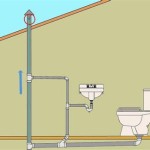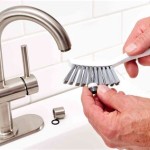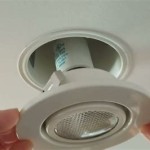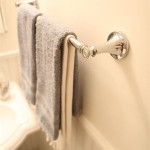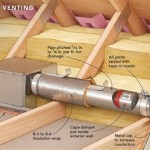Modern Bathroom Sink Faucets: A Comprehensive Guide
Modern bathroom sink faucets represent a significant departure from their more utilitarian predecessors. Functionality remains paramount, but aesthetic design, water conservation, and technological advancements have propelled these fixtures into a realm where form and function coalesce seamlessly. This article provides a comprehensive overview of modern bathroom sink faucets, examining their diverse styles, materials, technologies, and installation considerations to inform informed decision-making.
Styles and Designs of Modern Bathroom Sink Faucets
The landscape of modern bathroom sink faucets is characterized by a vast array of styles, each catering to different design preferences and bathroom aesthetics. Choosing the right style is critical to achieving a cohesive and visually appealing bathroom space. Some of the most prevalent styles include:
Single-Handle Faucets: These faucets feature a single lever that controls both water temperature and flow. Their streamlined design and ease of use make them a popular choice for modern bathrooms. The single-handle configuration also simplifies installation and maintenance. The simplicity often translates to a cleaner, more minimalist aesthetic.
Two-Handle Faucets: Offering separate handles for hot and cold water, two-handle faucets provide a more traditional aesthetic while still accommodating modern design sensibilities. They are available in various styles, from classic cross handles to sleek, contemporary lever designs. The separate controls allow for precise temperature adjustments, catering to individual preferences.
Widespread Faucets: These faucets consist of three separate pieces: two handles and a spout. They require three pre-drilled holes in the sink or countertop, providing a more substantial and visually striking presence. Widespread faucets are often chosen for larger sinks or countertops, where their wider spread complements the overall scale of the space.
Center-Set Faucets: Designed for sinks with three pre-drilled holes close together (typically 4 inches apart), center-set faucets often feature a single base unit incorporating both handles and the spout. Their compact design makes them suitable for smaller bathrooms or pedestal sinks where space is limited.
Wall-Mount Faucets: These faucets are mounted directly onto the wall above the sink, creating a clean and uncluttered look. They require careful planning and installation, as the plumbing connections are concealed within the wall. Wall-mount faucets offer a unique architectural element and can be particularly effective in minimalist or contemporary bathroom designs.
Vessel Faucets: Specifically designed for use with vessel sinks (sinks that sit on top of the countertop), vessel faucets are typically taller than standard faucets to accommodate the height of the sink. They often feature unique spout designs and waterfall effects, adding a touch of elegance and sophistication to the bathroom.
Beyond these primary styles, modern faucet designs incorporate various aesthetic elements, such as geometric shapes, organic curves, and bold finishes. The selection of a faucet style should always align with the overall design theme of the bathroom to create a harmonious and visually pleasing environment.
Materials and Finishes in Modern Bathroom Sink Faucets
The choice of materials and finishes significantly impacts the durability, performance, and aesthetic appeal of modern bathroom sink faucets. High-quality materials ensure longevity and resistance to corrosion, while thoughtfully selected finishes enhance the overall design and coordinate with other bathroom fixtures.
Brass: Brass is a common core material for bathroom faucets due to its durability, resistance to corrosion, and malleability. It allows for intricate designs and provides a solid foundation for various finishes. Lead-free brass is increasingly prevalent to meet health and safety regulations.
Stainless Steel: Known for its durability and resistance to rust and corrosion, stainless steel is a popular choice for modern bathroom sink faucets. It offers a clean, contemporary look and is relatively easy to maintain. Stainless steel faucets are often more expensive than those made of brass.
Zinc Alloys: While less expensive than brass or stainless steel, zinc alloys are sometimes used in faucet construction. However, they are generally less durable and more susceptible to corrosion over time. Zinc alloy faucets are typically found in lower-priced models.
The finishes applied to bathroom faucets not only enhance their aesthetic appeal but also provide a protective layer against wear and tear. Common finishes include:
Chrome: A classic and versatile finish, chrome offers a bright, reflective surface that is easy to clean and maintain. It complements a wide range of bathroom styles and is relatively affordable.
Brushed Nickel: Offering a softer, warmer look than chrome, brushed nickel features a subtle, matte finish that resists fingerprints and water spots. It is a popular choice for contemporary bathrooms.
Oil-Rubbed Bronze: This finish provides a rich, dark bronze hue with a textured surface. It is often used in traditional or rustic bathroom designs, adding a touch of warmth and character.
Matte Black: A modern and sophisticated finish, matte black adds a bold statement to any bathroom. It is highly versatile and complements a variety of color palettes. However, it may require more frequent cleaning to remove water spots and fingerprints.
Gold: Gold finishes, in both polished and brushed variations, provide a luxurious and elegant touch. They are often used in upscale bathrooms and can be paired with other opulent materials such as marble and crystal.
The selection of materials and finishes should consider the overall design style of the bathroom, as well as the desired level of durability and maintenance. Coordinating the faucet finish with other bathroom fixtures, such as showerheads, towel bars, and lighting, is essential for creating a cohesive and visually appealing space.
Technologies and Innovations in Modern Bathroom Sink Faucets
Modern bathroom sink faucets incorporate a range of technologies and innovations designed to enhance functionality, promote water conservation, and improve the overall user experience. These advancements reflect a growing emphasis on sustainability and convenience in bathroom design.
Touchless Technology: Utilizing infrared sensors, touchless faucets allow users to activate water flow without physically touching the faucet. This promotes hygiene, reduces the spread of germs, and conserves water by eliminating unnecessary water flow. Touchless faucets are particularly well-suited for high-traffic bathrooms or for individuals with mobility limitations.
Temperature Memory: Some faucets feature temperature memory technology, which allows the faucet to remember the user's preferred water temperature and automatically deliver it the next time the faucet is used. This eliminates the need to constantly adjust the temperature and provides a more convenient and consistent experience.
Water-Saving Features: Modern faucets often incorporate features designed to reduce water consumption without compromising performance. These include low-flow aerators, which mix air with water to create a strong stream while using less water, and pressure-balancing valves, which maintain a consistent water temperature and pressure even when other water sources are in use.
LED Temperature Indicators: Certain faucets feature LED lights that change color to indicate the water temperature. This provides a visual cue to prevent scalding and enhances safety, particularly for children and the elderly.
Digital Displays: Some high-end faucets incorporate digital displays that show the water temperature and flow rate. These displays provide precise control over water usage and allow users to monitor their water consumption.
Voice Control Integration: As smart home technology becomes increasingly prevalent, some faucet manufacturers are incorporating voice control integration. This allows users to control the faucet using voice commands, such as turning the water on or off, adjusting the temperature, or dispensing a specific amount of water.
The integration of these technologies enhances the functionality and efficiency of modern bathroom sink faucets. Choosing faucets with water-saving features and other innovative technologies can significantly reduce water consumption and contribute to a more sustainable lifestyle. As technology continues to evolve, further advancements in faucet design and functionality are anticipated.

Modern Bathroom Sink Faucets Isenberg

51 Bathroom Faucets To Complete Your Dream Sink Update

Modern Bathroom Collection Delta Faucet

Modern Single Handle One Hole Waterfall Bathroom Sink Faucet Solid Brass In Matte Black Homary

32 Creative Sink Faucets In Contemporary And Modern Designs Bathroom Accessories Chrome

Bwe Single Handle Hole Modern Bathroom Faucet Drip Free Vanity Sink In Polished Chrome A 96060 C The Home Depot

Kastel Basin Faucets Modern Bathroom Mixer Tap Single Handle Hole Crane Signature

Bwe Waterfall Single Handle Hole Low Arc Modern Bathroom Faucet Drip Free Vanity Sink In Brushed Nickel A 96063 N The Home Depot

Modern Bathroom Sink Faucets Isenberg

Wowow Modern Bathroom Faucet Oil Rubbed Broe 8 In Widespread 2 Handle Commercial Sink With Drain The Faucets Department At Com
Related Posts

